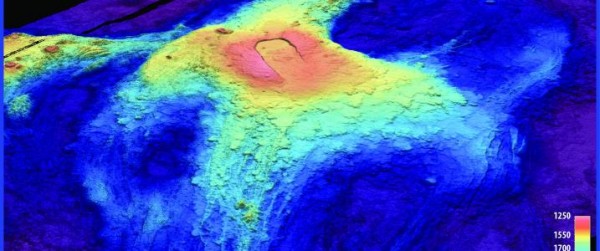Underwater Volcano in Oregon Coast Could Be Erupting Right Now
| Ana Verayo | | May 01, 2015 04:17 AM EDT |
(Photo : Oregon State University) The seafloor on Axial Seamount near Oregon coast dropped to almost 8 feet due to a volcanic eruption.
Located some three hundred miles from the Pacific Northwest coastal area, the seafloor rumbles where over the past five months, hundreds of small earthquakes are experienced almost everyday on Axial Seamount.
However, on April 24 a spike was recorded with nearly 8,000 earthquakes in one day as the seafloor dropped to two meters and temperatures were significantly high. Scientists now believe that an underwater volcano could be erupting somewhere.
Like Us on Facebook
This eruption is apparently not a threat to residents living off the coast as the earthquakes are measured at magnitudes 1 or 2 and the seafloor movements are occurring gradually meaning this will not likely cause a tsunami.
Scientists also say that this volcanic activity is not linked to the Cascadia Subduction Zone that scientists were observing closely for signs of a larger earthquake that can cause unprecedented destruction.
However according to geologist Bill Chadwick from the Orgeon State University, this eruption from the Axial Seamount is not a surprise as he predicted this event happening this year. Chadwick along with Scott Nooner from the University of North Carolina Wilmington also believes that the Axial Seamount phenomenon can also be applied to volcanoes on the land.
Volcanoes found on the land possess thicker crusts which are triggered by larger earthquakes along with other nearby volcanoes which make predictions more challenging. However he says that Axial Seamount has relatively "simple plumbing".
Axial Seamount is now being monitored and studied for signals via real time using cables on the sea floor where this cable is part of the Ocean Observatories Initiative that is funded by the National Science Foundation.
Chadwick believes that this underwater volcano is filled with very fluid magma that is being continuously supplied from below where this resulted in the seafloor rising up to more than eight feet. These recent earthquakes are also caused by this magma forcing itself through rock under the seafloor.
TagsUS, Oregon, underwater volcano oregon, volcano erupting oregon, axial seamount
©2015 Chinatopix All rights reserved. Do not reproduce without permission
EDITOR'S PICKS
-

Did the Trump administration just announce plans for a trade war with ‘hostile’ China and Russia?
-

US Senate passes Taiwan travel bill slammed by China
-

As Yan Sihong’s family grieves, here are other Chinese students who went missing abroad. Some have never been found
-

Beijing blasts Western critics who ‘smear China’ with the term sharp power
-

China Envoy Seeks to Defuse Tensions With U.S. as a Trade War Brews
-

Singapore's Deputy PM Provides Bitcoin Vote of Confidence Amid China's Blanket Bans
-

China warns investors over risks in overseas virtual currency trading
-

Chinese government most trustworthy: survey
-

Kashima Antlers On Course For Back-To-Back Titles
MOST POPULAR
LATEST NEWS
Zhou Yongkang: China's Former Security Chief Sentenced to Life in Prison

China's former Chief of the Ministry of Public Security, Zhou Yongkang, has been given a life sentence after he was found guilty of abusing his office, bribery and deliberately ... Full Article
TRENDING STORY

China Pork Prices Expected to Stabilize As The Supplies Recover

Elephone P9000 Smartphone is now on Sale on Amazon India

There's a Big Chance Cliffhangers Won't Still Be Resolved When Grey's Anatomy Season 13 Returns

Supreme Court Ruled on Samsung vs Apple Dispute for Patent Infringement

Microsoft Surface Pro 5 Rumors and Release Date: What is the Latest?










